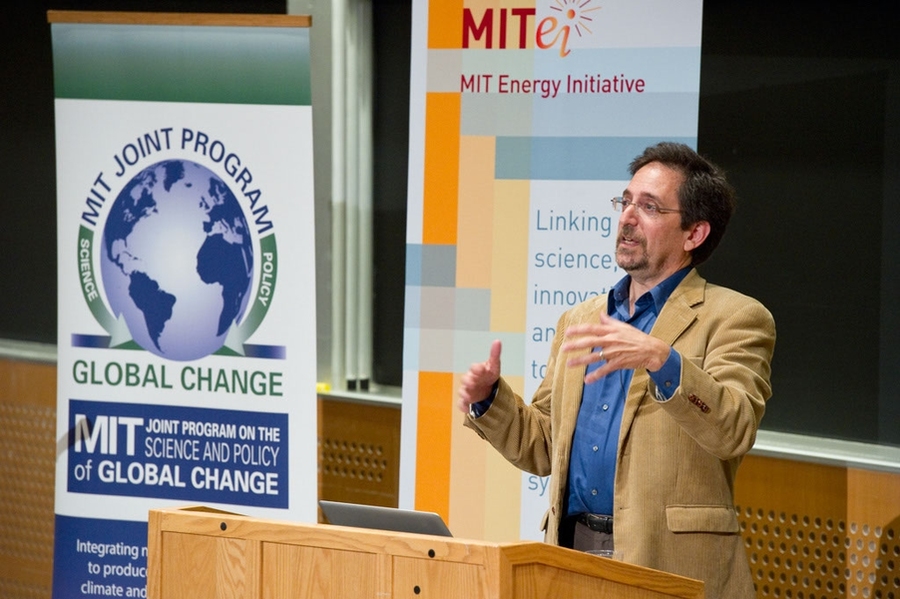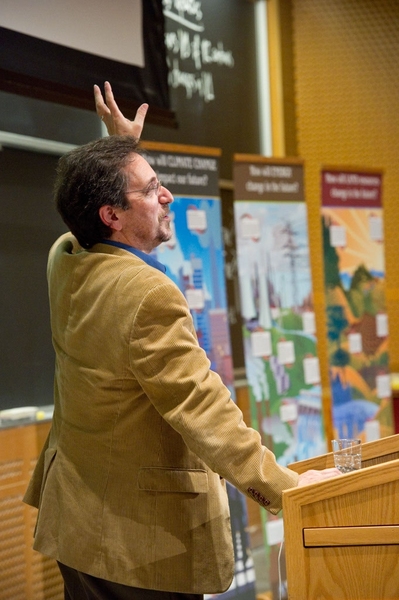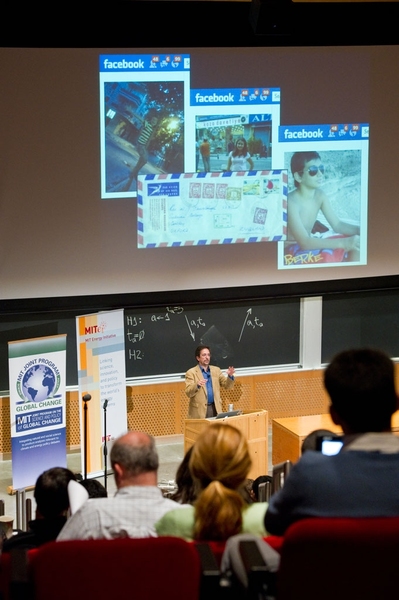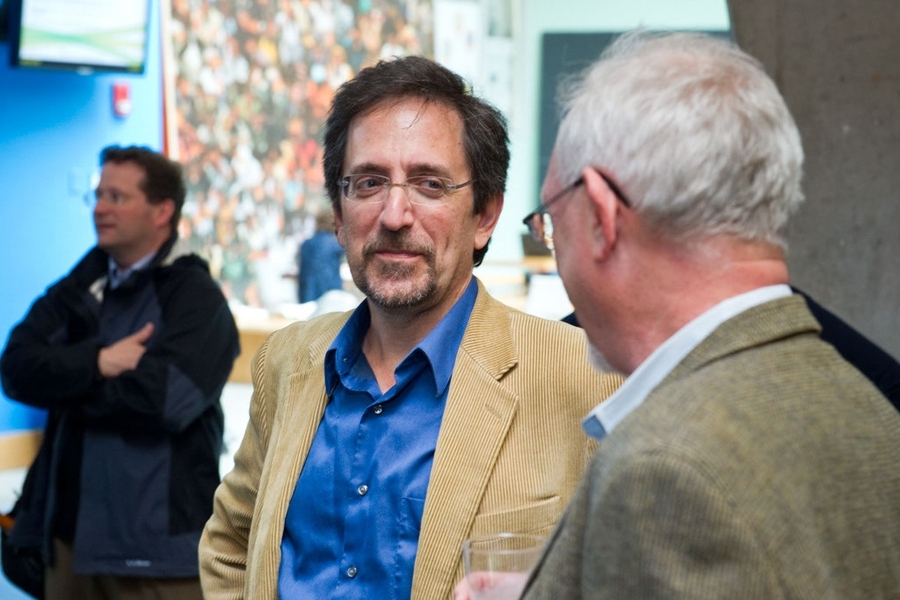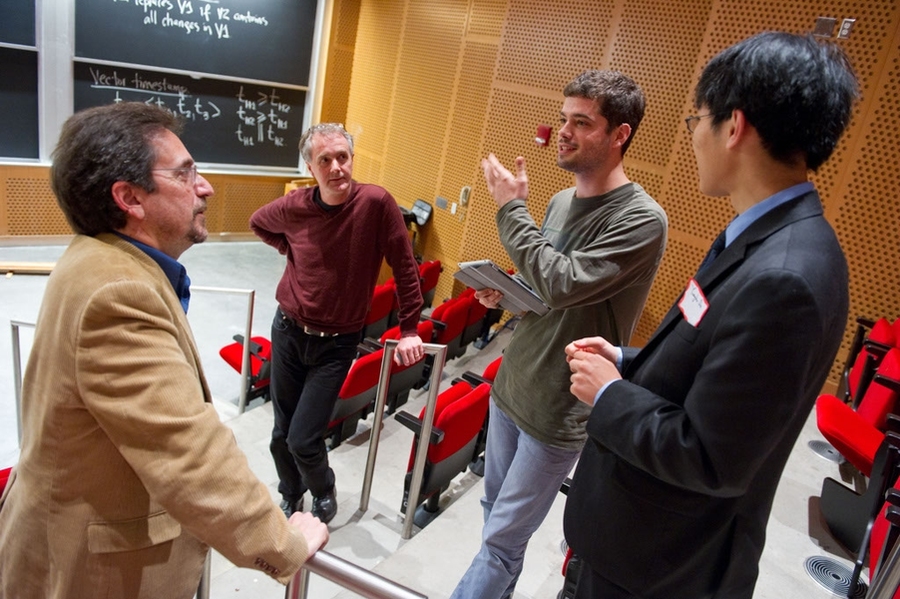Using new ways to confront persistent challenges is one of MIT’s greatest strengths, and an idea reinforced this week in regard to climate change by the New York Times writer Andrew Revkin, author of the Dot Earth blog.
“There’s never been a better time to share and shape and collaborate” to help communicate and confront complex challenges such as climate change, said Revkin, who visited MIT on Monday, April 23, as part of an Earth Day colloquium hosted by the MIT Energy Initiative, the Joint Program on the Science and Policy of Global Change and the Program in Atmospheres, Oceans, and Climate.
The Intergovernmental Panel on Climate Change (IPCC), created to better communicate the issue to the general public, is partly to blame, according to Revkin, because it has used a warning tone, “sort of like the adult talking to the teenager. If you don’t do X, Y will happen,” he said. “And it hasn’t really worked that well, has it?”
Revkin believes web advancements and changes in the media have made it easier to connect and share ideas — fundamentally changing the way climate change can not only be communicated, but confronted.
“Don’t count on guys sitting around a table to get the work done. Most of the work will come from the bottom up,” Revkin said.
In this way, he said we’re “moving toward having a planet of the mind” which is building a “knowosphere” — a network of organizations eager to collaborate in fostering human progress on a finite but thriving planet. Revkin gave several examples from his travels and research — including how Yonkers, N.Y., is working to unearth a submerged river after hearing of the success Seoul, South Korea, had with a similar project.
Right here on MIT’s campus, the Climate CoLab specializes in this type of collaboration, and is harnessing the collective intelligence of thousands of people around the world to collect proposed ways to take up climate change. The proposals are then part of annual contests.
Along with using new technology to develop collective thinking and discover best practices, Revkin said we also need to use new ways to explain challenges in the first place to gain more public understanding and support. He called this “getting out of the nerd loop.”
MIT has had recent success on this front as well. The MIT Museum just debuted its “Rivers of Ice” exhibit, which demonstrates glacial melt in the Himalayas by comparing new and old photography. A Knight Journalism Fellow is using a similar concept in his new “To Extremes” exhibit that uses pieces of art to represent complex climate change topics.
This idea of using visual tools to help explain climate change is something MIT’s Joint Program on the Science and Policy of Global Change has done for years with its Greenhouse Gamble Wheels, which demonstrate the uncertainty of warming under policy and no-policy scenarios. Each spin of the wheel gives a different possible warming outcome.
Revkin finds talking about uncertainty, a topic many are reluctant to broach, to be especially important. He again used the example of the IPCC’s failure in this regard, recalling a time when it advised researchers in a media tip sheet not to use words such as “uncertainty” because the public has a different understanding of it.
“It’s the inverse. Embrace the word. Use it. Uncertainty is a form of knowledge,” Revkin said, adding that it’s an “opportunity to educate.”
Whatever the topic, Revkin said the key to effectively communicating — and tackling — these challenges today is having a “willingness to experiment with new ways to say the same thing.”
For students, that means “at least just touching the stove to learn that its hot yourself, and not being fearful of experimenting … just because someone tells you it’s scary.”
“There’s never been a better time to share and shape and collaborate” to help communicate and confront complex challenges such as climate change, said Revkin, who visited MIT on Monday, April 23, as part of an Earth Day colloquium hosted by the MIT Energy Initiative, the Joint Program on the Science and Policy of Global Change and the Program in Atmospheres, Oceans, and Climate.
- Video: Watch the event
The Intergovernmental Panel on Climate Change (IPCC), created to better communicate the issue to the general public, is partly to blame, according to Revkin, because it has used a warning tone, “sort of like the adult talking to the teenager. If you don’t do X, Y will happen,” he said. “And it hasn’t really worked that well, has it?”
Revkin believes web advancements and changes in the media have made it easier to connect and share ideas — fundamentally changing the way climate change can not only be communicated, but confronted.
“Don’t count on guys sitting around a table to get the work done. Most of the work will come from the bottom up,” Revkin said.
In this way, he said we’re “moving toward having a planet of the mind” which is building a “knowosphere” — a network of organizations eager to collaborate in fostering human progress on a finite but thriving planet. Revkin gave several examples from his travels and research — including how Yonkers, N.Y., is working to unearth a submerged river after hearing of the success Seoul, South Korea, had with a similar project.
Right here on MIT’s campus, the Climate CoLab specializes in this type of collaboration, and is harnessing the collective intelligence of thousands of people around the world to collect proposed ways to take up climate change. The proposals are then part of annual contests.
Along with using new technology to develop collective thinking and discover best practices, Revkin said we also need to use new ways to explain challenges in the first place to gain more public understanding and support. He called this “getting out of the nerd loop.”
MIT has had recent success on this front as well. The MIT Museum just debuted its “Rivers of Ice” exhibit, which demonstrates glacial melt in the Himalayas by comparing new and old photography. A Knight Journalism Fellow is using a similar concept in his new “To Extremes” exhibit that uses pieces of art to represent complex climate change topics.
This idea of using visual tools to help explain climate change is something MIT’s Joint Program on the Science and Policy of Global Change has done for years with its Greenhouse Gamble Wheels, which demonstrate the uncertainty of warming under policy and no-policy scenarios. Each spin of the wheel gives a different possible warming outcome.
Revkin finds talking about uncertainty, a topic many are reluctant to broach, to be especially important. He again used the example of the IPCC’s failure in this regard, recalling a time when it advised researchers in a media tip sheet not to use words such as “uncertainty” because the public has a different understanding of it.
“It’s the inverse. Embrace the word. Use it. Uncertainty is a form of knowledge,” Revkin said, adding that it’s an “opportunity to educate.”
Whatever the topic, Revkin said the key to effectively communicating — and tackling — these challenges today is having a “willingness to experiment with new ways to say the same thing.”
For students, that means “at least just touching the stove to learn that its hot yourself, and not being fearful of experimenting … just because someone tells you it’s scary.”
